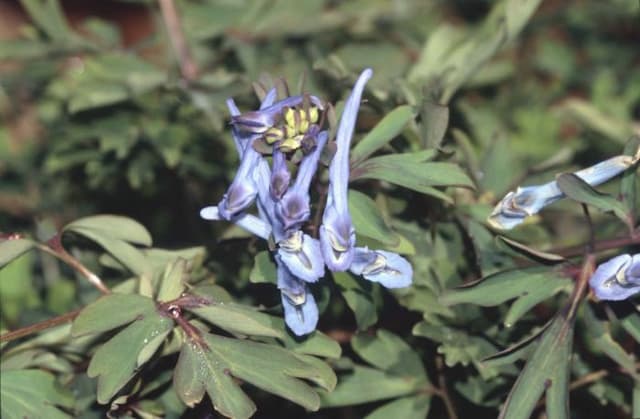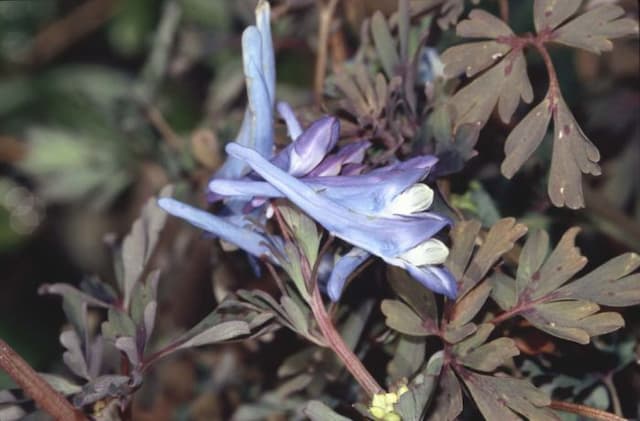Blue Poppy Meconopsis (Infertile Blue Group) 'Mrs Jebb'

ABOUT
The Meconopsis 'Mrs Jebb', commonly known as the Blue Poppy, is a captivating plant characterized by its stunningly vibrant blooms. The petals of this enchanting flower are a rich, sky blue or azure hue, which stands out distinctively against the surrounding foliage. These petals appear delicate and satiny, almost shimmering with a silky sheen when caught by the light. At the center of each flower, a group of golden yellow stamens cluster together, providing a striking contrast that further accentuates the boldness of the blue petals. The Blue Poppy's leaves are a lush green, forming a basal rosette from where the blooms rise. The leaves often have a slight sheen, with their edges finely toothed or lightly ruffled, adding to the plant's overall textural interest. Its foliage complements the flowers by providing a rich backdrop that enhances the visual appeal of the blooms. The arrangement of the flowers is equally alluring. Each bloom perches on its own stalk, emerging elegantly from among the basal leaves. The blooms tend to face upward or slightly outward, as if inviting admiration of their stunning colors and form. In full bloom, the Blue Poppy presents a captivating display that is both exotic and graceful. It is popular among gardeners and plant enthusiasts who wish to add a splash of cool-toned color to their landscapes.
About this plant
 Names
NamesFamily
Papaveraceae
Synonyms
Blue Poppy, Himalayan Poppy
Common names
Meconopsis (Infertile Blue Group) 'Mrs Jebb'
 Toxicity
ToxicityTo humans
The Blue Poppy (Meconopsis) is not generally listed as a toxic plant to humans. There are no well-documented cases or evidence to suggest that the Blue Poppy, including the 'Mrs Jebb' variety, contains significant levels of toxic compounds that would cause poisoning if ingested. While the Blue Poppy does not have a reputation for being hazardous, it is still advised that humans do not consume ornamental plants as they are not intended for human consumption, and individual allergies or sensitivities to plants can occur.
To pets
The Blue Poppy (Meconopsis) is not typically recognized as toxic to pets such as dogs and cats. There is limited information on the specific toxicity of the 'Mrs Jebb' variety to pets, but there is no notable evidence indicating that the Blue Poppy presents a significant risk of poisoning to animals if they ingest it. However, as with humans, it is generally best to prevent pets from eating ornamental plants as they are not part of an animal's natural diet, and consumption can sometimes lead to gastrointestinal upset due to the novelty and potential irritants.
 Characteristics
CharacteristicsLife cycle
Perennials
Foliage type
Deciduous
Color of leaves
Green
Flower color
Blue
Height
4 feet (1.22 meters)
Spread
2 feet (0.61 meters)
Plant type
Herb
Hardiness zones
6
Native area
Himalayas
Benefits
 General Benefits
General Benefits- Ornamental Value: Meconopsis 'Mrs Jebb' adds striking beauty to a garden with its vibrant blue flowers, offering a spectacular display when in bloom.
- Pollinator Attraction: The flowers attract bees and other pollinators, supporting local ecosystems and aiding in the pollination of other plants.
- Garden Diversity: Introducing this plant contributes to the horticultural diversity of a garden, providing interesting foliage and unique flower forms.
- Shade Tolerance: As a woodland plant, it thrives in dappled shade, making it suitable for gardens with limited direct sunlight.
- Cool Climate Adaptation: Meconopsis 'Mrs Jebb' is suited to cooler climates, which can be an advantage in northern gardens where other plants may struggle.
- Seasonal Interest: With a blooming period typically in late spring or early summer, it provides a burst of color after many spring bulbs have faded.
- Habitat Creation: It creates a micro-habitat for small creatures and insects, contributing to biodiversity within the garden space.
- Soil Improvement: The plant can help improve soil quality over time, through natural leaf litter and root systems.
- Emotional Wellbeing: The presence of flowering plants like Meconopsis 'Mrs Jebb' in the environment can improve human wellbeing by enhancing mood and providing a sense of tranquility.
 Medical Properties
Medical PropertiesThis plant is not used for medical purposes.
 Air-purifying Qualities
Air-purifying QualitiesThis plant is not specifically known for air purifying qualities.
 Other Uses
Other Uses- Meconopsis can be used as a natural fabric dye, giving a range of blue shades depending on the mordant used.
- In artistic representations, the striking blue of Himalayan blue poppy is often used to add a splash of color to paintings and botanical illustrations.
- They can serve as a teaching tool in botany and horticulture programs to illustrate plant breeding and hybridization techniques.
- The petals of the Himalayan blue poppy have been traditionally used in some cultures to create a natural, biodegradable confetti.
- Photography enthusiasts often use the vivid blue flowers as a subject to practice macro and nature photography skills.
- The plant's distinct blue hue is sometimes used in color therapy and design to evoke a sense of calm and serenity.
- Himalayan blue poppy can be incorporated into theme gardens, such as blue or cool-colored gardens, to create a visually harmonious landscape.
- Due to its unique appearance, the flower can be used as inspiration for custom jewelry designs, particularly artisan-crafted floral pieces.
- Its image can be used for stamps or in coinage as a representation of native flora in countries where it naturally occurs.
- They can be grown as part of conservation efforts to maintain biodiversity and protect unique plant species in botanical gardens.
Interesting Facts
 Feng Shui
Feng ShuiThe Blue Poppy is not used in Feng Shui practice.
 Zodiac Sign Compitability
Zodiac Sign CompitabilityThe Blue Poppy is not used in astrology practice.
 Plant Symbolism
Plant Symbolism- Hope: The Meconopsis, commonly known as the "Blue Poppy," often symbolizes hope due to its bright and striking blue flowers that can stand out in any garden, offering a sense of optimism and anticipation.
- Peace: Its serene blue hues are reminiscent of tranquil skies and calm waters, conveying a sense of peace and tranquility.
- Dreams: The rarity and unique beauty of the Blue Poppy might represent the pursuit or realization of dreams, encouraging people to follow their aspirations.
- Rarity: Since it's a less common garden plant and because true blue flowers are rare in nature, the Blue Poppy can symbolize rarity or uniqueness in the plant world.
- Beauty: The Blue Poppy, with its captivating appearance, is often associated with beauty, emphasizing the appreciation of natural aesthetics.
 Water
WaterThe Himalayan Blue Poppy should be watered deeply once a week, with approximately 1-2 gallons of water to saturate the soil around the root zone. Adjust the watering frequency by monitoring the soil moisture; it should be consistently moist but not waterlogged. During hotter periods or in drier climates, increase watering to twice a week. Always avoid overhead watering to prevent fungal diseases, and try to water early in the day so the plant has time to dry before nightfall.
 Light
LightThe Himalayan Blue Poppy thrives best in partial shade, protected from the harsh afternoon sun. A spot that receives filtered light or morning sun followed by afternoon shade is ideal. Ensure that enough light reaches the plant to encourage growth but not so much that it scorches the delicate foliage.
 Temperature
TemperatureThe Himalayan Blue Poppy prefers cooler temperatures and can survive minimum temperatures down to about 32ºF. They grow best when daytime temperatures are between 50ºF and 65ºF. Avoid areas that experience prolonged temperatures above 80ºF, as the heat can be detrimental to the plant's health.
 Pruning
PruningThe Himalayan Blue Poppy benefits from pruning to remove spent flowers and encourage further blooming. Deadhead faded flowers regularly throughout the flowering season. After blooming has finished, cut back the flowering stems to maintain a tidy appearance and discourage disease. The best time for pruning is immediately after the flowering cycle ends.
 Cleaning
CleaningAs needed
 Soil
SoilThe best soil mix for the Himalayan Blue Poppy ‘Mrs Jebb’ should be a well-draining, humus-rich mix with added leaf mold or compost to retain moisture. The soil should be slightly acidic to neutral, with a pH ranging from 6.0 to 7.0. Regularly amending the soil with organic matter will help maintain the desired texture and acidity.
 Repotting
RepottingHimalayan Blue Poppies, like ‘Mrs Jebb’, should generally be repotted only when necessary, such as when they outgrow their current container or the soil becomes depleted, which may be every 2-3 years. These plants have sensitive root systems and prefer to be undisturbed, so repotting should be done with care.
 Humidity & Misting
Humidity & MistingHimalayan Blue Poppies prefer a high humidity environment. To thrive, ‘Mrs Jebb’ should be kept in conditions where the humidity level is consistently above 60%, resembling their native damp woodland habitats. Avoid placing them in dry, arid conditions which can stress the plant.
 Suitable locations
Suitable locationsIndoor
Ensure cool temperatures, bright indirect light, and high humidity for indoor growth.
Outdoor
Part shade, sheltered location, consistently moist soil, cool climate.
Hardiness zone
5-7 USDA
 Life cycle
Life cycleThe Meconopsis 'Mrs Jebb', commonly known as Blue Poppy, begins its life as a seed, which, when sown in moist, well-drained soil and given the right conditions of cool temperatures and shade, will germinate. The seedlings develop into rosettes of leaves during their first year, focusing on vegetative growth and establishing a strong root system. In the second year, the plant will send up a flowering stalk if the environmental conditions remain cool and moist, which is crucial for its growth. The Blue Poppy blooms in late spring to early summer, displaying striking large blue flowers that attract pollinators such as bees. After flowering, the plant sets seeds, which are then dispersed to give rise to new plants, completing the reproductive cycle. This species is monocarpic, meaning that after it flowers and sets seed, the individual plant typically dies, though in cultivation, and if prevented from setting seed, they may occasionally survive to flower for a few more years.
 Propogation
PropogationPropogation time
Spring to Early Summer
The most popular method of propagation for the Himalayan Blue Poppy (Meconopsis 'Mrs Jebb') is by sowing seeds. Optimal seed sowing is done in late winter to early spring, in containers filled with a well-draining seed mix. The seed should be surface sowed and lightly covered with a thin layer of soil, as they require light to germinate. The soil should be kept moist but not overly wet, with a temperature range of 50 to 60 degrees Fahrenheit (10 to 15.5 degrees Celsius), which typically can be provided by a shaded cold frame or greenhouse. Germination can be erratic and may take several weeks. Once the seedlings are large enough to handle, they should be transplanted into individual pots and grown on in cooler conditions until large enough to plant out in their final positions.









